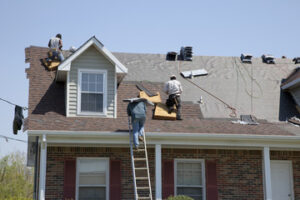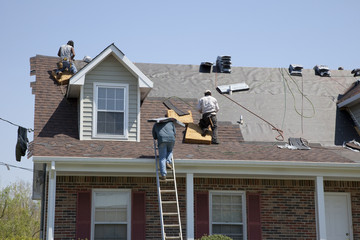Whether the goal is to keep the sun out and the heat in or the opposite, proper roofing choices make your house more energy-efficient. These choices can also significantly reduce utility bills.
 Roofs protect the interior of buildings from rain, snow, sunlight, extreme temperatures, and winds. There are many different roofing materials and construction methods.
Roofs protect the interior of buildings from rain, snow, sunlight, extreme temperatures, and winds. There are many different roofing materials and construction methods.
History
As long as humans have existed there has been a need for shelter and roofing. The roof is a vital part of any building that provides protection from the elements, defines its exterior aesthetic and is often one of the first things that people notice about a structure. It is a fundamental part of every home and commercial building and has inspired thousands of years of architectural styles and developments.
In the early days of human evolution, the most basic need was to find or build shelter for themselves and their families. As early man began to move out of caves and onto the open land, they needed a place to live that provided protection from the harsh weather conditions they encountered. These early shelters were rudimentary and were made from whatever material was available at the time. Whether it was woolly mammoth skins, wood or rocks, the construction of these simple homes had to be as rugged as the terrain on which they stood.
The first permanent buildings and roofs began to develop around 40,000 BC. Early tent-like structures were constructed with reeds and mud that formed a conical shape to protect the inhabitants. As farming developed in these areas, rectangular huts with flat roofs were built using mud bricks and eventually stone became the preferred building material. In Egypt in the 3000’s BC, pyramids were built of stone that was brought from great distances by camel caravans.
Throughout history roofing has been a very important part of human life and as such has continued to evolve. With the introduction of new technologies, materials and manufacturing processes roofing has become much more refined and advanced.
The most popular type of roofing used in Europe in the 1700’s was natural slate or clay tiles, largely depending on which materials were easily accessible in each region. In areas where wood was abundant, thatch was used for roofing. This roofing style was also popular in equatorial countries due to its flexibility and lightweight nature. Asphalt shingles were introduced in the 1800’s and replaced wood shingle roofing because of the fire issues associated with this type of roof.
Materials
Roofing is one of the most visible parts of a home, adding to its aesthetic and communicating its style and design. Updating the roof is a great way to add value to your home and ensure it’s safe and weather-resistant. Choosing the right materials is essential to avoid costly repairs down the road.
The most popular roofing material is asphalt shingles, which are available in a variety of styles and colors to complement your home. They’re also relatively inexpensive and can last for up to 50 years.
Metal roofing is another durable option, made from a wide variety of materials including copper, steel, and aluminum. It can be molded to mimic other roofing materials, such as shingles or shakes, and is weather- and fire-resistant. Metal roofs are also lightweight and can be installed on flat or low-sloped roofs.
Another natural roofing material is slate, a type of rock that comes in several different shades and can last up to 200 years. Slate roofs are expensive, however, and require a heavy-duty underlying roof structure that must be designed to support the weight of the slate. Additionally, slate requires a specialist to install and is more difficult to repair than other roofing materials.
Clay tiles are a common roofing material in hot climates and are molded and fired for durability. They’re available in a variety of shapes and can be interlocked to form patterns. They’re more affordable than slate but are heavier and add significant weight to a roof, which can cause structural damage.
A less traditional roofing option is a green roof, which is essentially a small garden in the shape of your roof. Green roofs are great for managing water runoff and insulating a house, while also putting clean oxygen back into the air. Green roofs are also more expensive than other roofing materials and need extensive maintenance. Another option is membrane roofing, which is an affordable choice for low-slope or flat roofs and consists of large sheets of waterproof material topped with mineral granules. It’s also resistant to rot and insects.
Installation
To begin the installation process, the roofers will need to tear off any old shingles and sheathing that is not in good shape. This is done by using a large pry bar and drill to loosen the nails that hold each panel in place, then working from one side to the other to unhook them and pull them off. The sheathing will be inspected at this time for water damage and to see if it is in need of replacement.
The underlayment is then installed. Felt paper is the most common, and it creates a barrier between your home and the elements. The roofer will run it along the edge of the roof, over the ice and water barrier and drip edge. It will be nailed down in a pattern that is close together at the edges and further apart towards the middle. This is then repeated for the other side of the roof.
Maintenance
A roof is a big investment, and studies demonstrate that roofing systems that are not properly maintained only last a third to half of their lifespan. To avoid structural damage, a routine inspection and maintenance program should be established.
Look for deteriorated shingles, missing shingle tabs, and cracking caulking. If you see areas that are opening up or displaying signs of leaking, make the necessary repairs now to save money down the road.
Pay special attention to the flashing around your chimney and vent pipes, as well as any places where your shingle ends meet the wood trim of your home. Check the caulk to be sure it is in good condition, and look for any areas where moss or lichen are growing.
The ridgelines of your roof are capped with triangular pieces that protect any cracks or separation between shingles and tiles, but these ridge caps can wear out and break down. When this occurs, water can leak into your home through the exposed ridgeline.
The most basic maintenance task is to keep the roof clear of debris. Debris accumulation can cause ponding water that damages the roof assembly, and it can also block the flow of rainwater to the roof drains. If you have large trees near your home, regularly trim branches that hang over the roof. This will help prevent limbs from breaking off in a storm, and it will keep your roof debris-free. Also, check the ventilation and eaves troughs on a regular basis to ensure they are free from leaves, birds’ nests, or insects.

